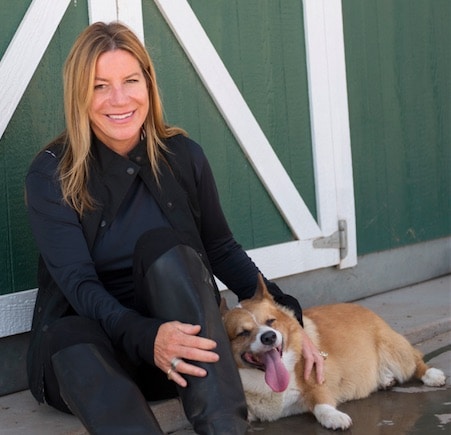
Lara Morabito: Nationals Ballpark Garden Designer
BY PAKSY PLACKIS-CHENG
Lara Morabito has designed more than 33 gardens, from Washington, D.C., to the Bay Area of California. Most recently, she designed the garden spaces at the Nationals ballpark.
Currently, Lara Morabito is building formal gardens for a private residence, The Reach, on the Eastern Shore of Maryland. The residence was designed by renowned architect Hugh Newell Jacobsen, who considers this residence to be one of the jewels of his practice.
The gardens surrounding the residence include several sculptures by renowned sculptor Aristides Demetrios, with whom Morabito is currently collaborating.
impactmania met Morabito at Nora, one of her favorite restaurants in Washington, D.C.
Why garden design?
My father was an organic gentleman farmer in Ohio, he grew organic vegetables for his family long before it was fashionable. He bought tomato seeds from San Marzano, Italy back when no one heard of San Marzano nor their tomatoes. Now, top chefs around the world say it’s the only tomato to use, he was a garden pioneer.
Our land was adjacent to the private estate of industrialist Cyrus Eaton, who was very involved in Russian-American relations in the 60’ and 70’s. Cyrus had a vast 300 acre cattle ranch with a dairy farm, apple orchards, and hunter stables. I had access to his enormous library including art, architecture and garden books. I was in love with it all, but was particularly drawn to the neat and tidy rows of vegetables, long citrus allées and banks of roses. I must have been an odd child I loved growing things in little rows and watching the transformation.
The whole culture seeped into my being: family, food, horses, livestock and of course garden making.
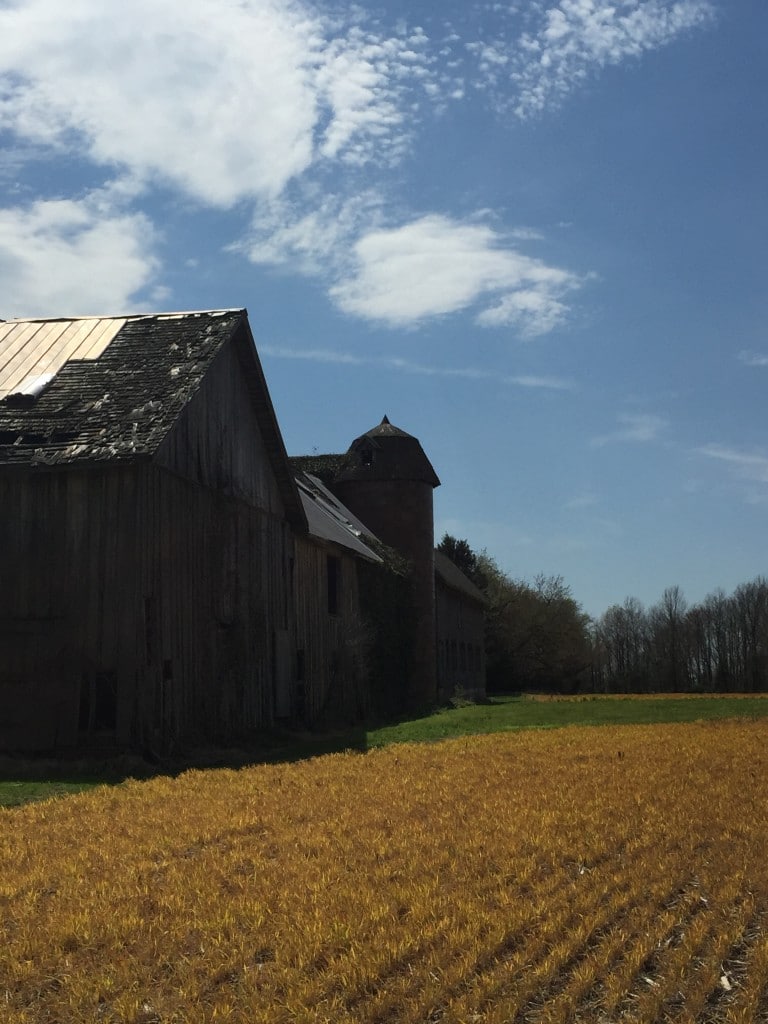
Cyrus Eaton’s barn
Your family still owns the land?
Yes, I have five sisters and a brother; we own the land together. Our parents are gone but my siblings still live nearby. Unfortunately, Cyrus Eaton’s grandson sold his land and the farm is gone, but the memory will always be with me.
As a young mother of four children [in Washington, D.C.] I began to cultivate my own acre of land as my father once did. My children were small. I started with a rose garden; cuttings from my mother’s own roses, vegetables and fig trees came later. Remembering how to propagate, I refined my skills while my children were still small and played in the garden that I worked. As a child, you are not aware of the information you’re taking in. All those afternoons on the farm, in the vegetable gardens, helping my father work the land; they all came back to me when I was cultivating my own little piece of earth.
What is it like to design green space for a baseball park?
I love baseball. It is the one sport I could get lost in, and maybe attend every home game. There are close to 80 games a year! It is the longest season of any sport. Bringing green spaces into these otherwise urban, concrete venues is a trend in professional sports.
I kept thinking about how baseball was born as an American backyard sport: small children in a field, usually rural areas, playing baseball. I used that imagery as my inspiration. Grasses, trees, and flowers… we planted herbs and vegetables in huge containers all over the ballpark with cherry tomatoes on fences, to bring back that feeling of that American backyard sport.
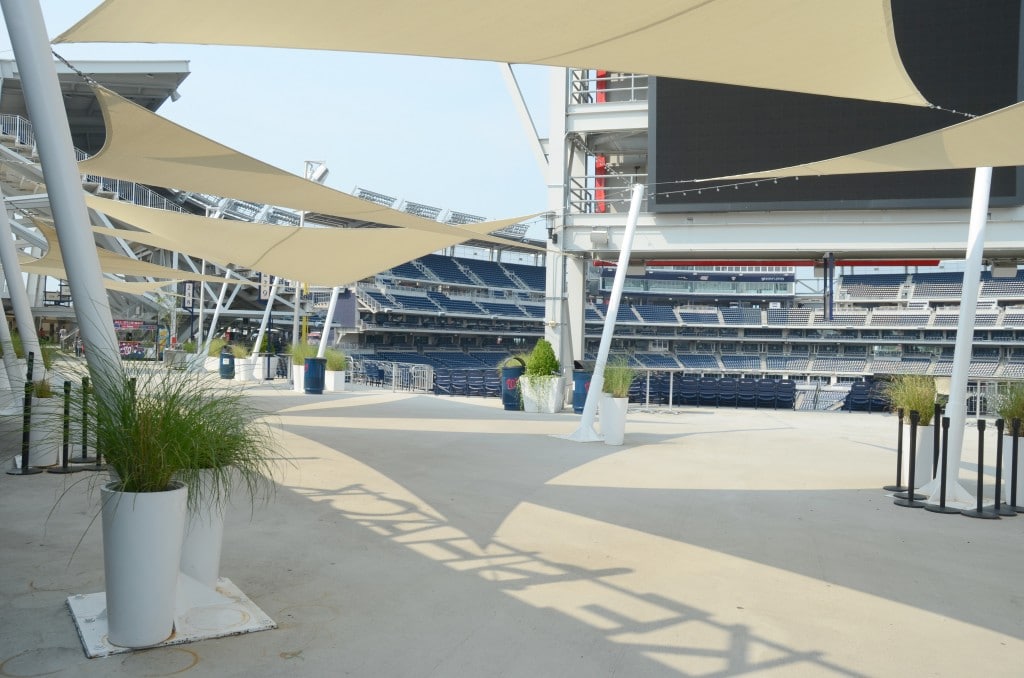
Nationals baseball park. Photo by Lanah Fitzgerald.
What is an important design element for a baseball park that is different from a residence?
The scale and amount of people who will visit the garden during the season, the garden can’t be too precious. When I designed the outdoor garden for the Nationals ballpark, I thought a lot about when my children were little and how we would stand in line for a hot dog in the hot sun, and how when they were toddlers, they were kind of stuck in a seat, and nowhere to go. I was asked to design the outdoor space adjacent to Danny Meyer’s Shake Shack. Eateries like Shake Shack and The Taqueria are wildly popular with families. We brought in shade, large trees, boxwood, a living wisteria wall, high end outdoor furniture with Scalamandre fabric in iconic navy and white baseball stripes. It is really a great place to hang out and watch the game.
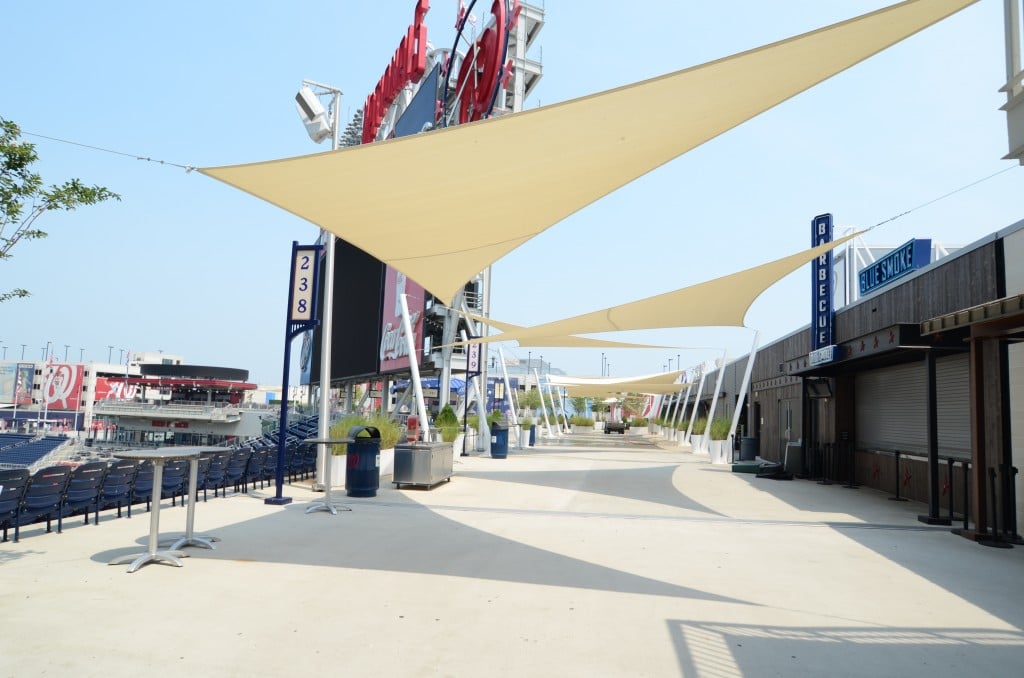
Sails at the Nationals baseball park concessions. Photo by Lanah Fitzgerald.
As a nod to the historic Navy Yard across from the ballpark and in attempt to bring down the ambient outdoor temperatures, we installed a series of shade sails by the young innovative company, Tenshon. The Navy Yard was actually a secret ammunition’s port in both World Wars. It seemed only fitting to honor The Navy Yard while providing cool, shaded spaces for families to gather amongst the concessions.
Currently, you’re working on The Reach, a very special project.
We are designing the formal gardens for a Hugh Newell Jacobsen designed private estate. Many consider Mr. Jacobsen to be the Frank Lloyd Wright of our time. Playful and pristine define a Jacobsen designed house. There is a nod to tradition yet the exterior and interiors are very minimal. There is no clutter, the lines are clean, and the axis very long. Formal gardens were never designed for this property, which is really very unusual.
How large are the grounds?
We are cultivating about 10 acres; the additional 15 acres are agricultural fields that set the stage for the pristine white house at the center. The fields go back to my childhood and those neat tidy rows and large square spaces of agricultural land.
To honor Jacobsen’s design and intent, the gardens will have a minimalist quality drawing from the strength and history of Renaissance gardens. The approach to the house is a constant drum roll as you travel the long pea gravel driveway. The gardens are a continuation of this affect, rhythmically, until you reach the Miles River.
The central theme of the house and garden are the long axis, sparse yet inviting.
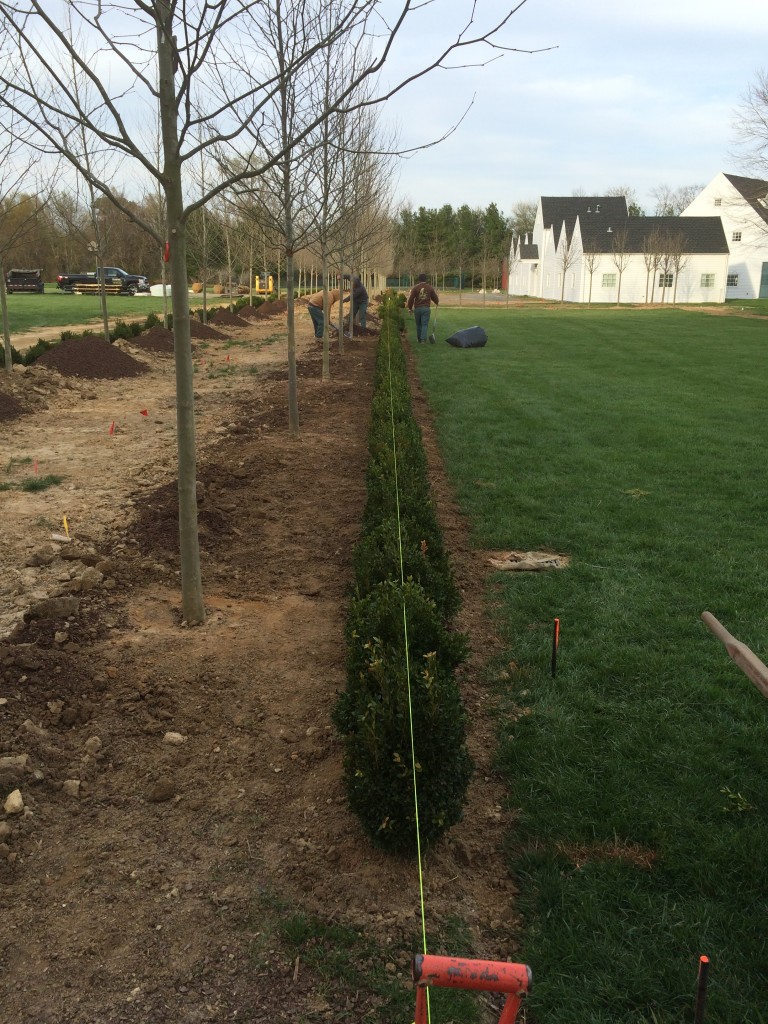
Garden at The Reach
This must be a dream project.
It is. It’s a blank canvas. Formal gardens by some of the most celebrated landscape architects adorn building sites all over Washington, D.C. As a 30 year resident and student of garden design I have learned from the greats what constitutes great garden design.
With The Reach, I know what the garden is meant to be; the architect told me what he wanted by the way he designed the house. I have never met Mr. Jacobsen, though we live in the same town. I wanted my designs to be pure and unaffected and I feared I would be intimidated to meet Mr. Jacobsen too early in the design process. I look forward to the day I can show him the gardens at The Reach.
Another exciting element is that the original owners commissioned several sculptures from a California based sculptor, Aristides Demetrios, who is perhaps best known for his garden sculptures, and lyrical bronze fountains. I am thrilled to be collaborating with Aris on repositioning some of the original sculptures, for this marquis garden and the Reach’s new owners.
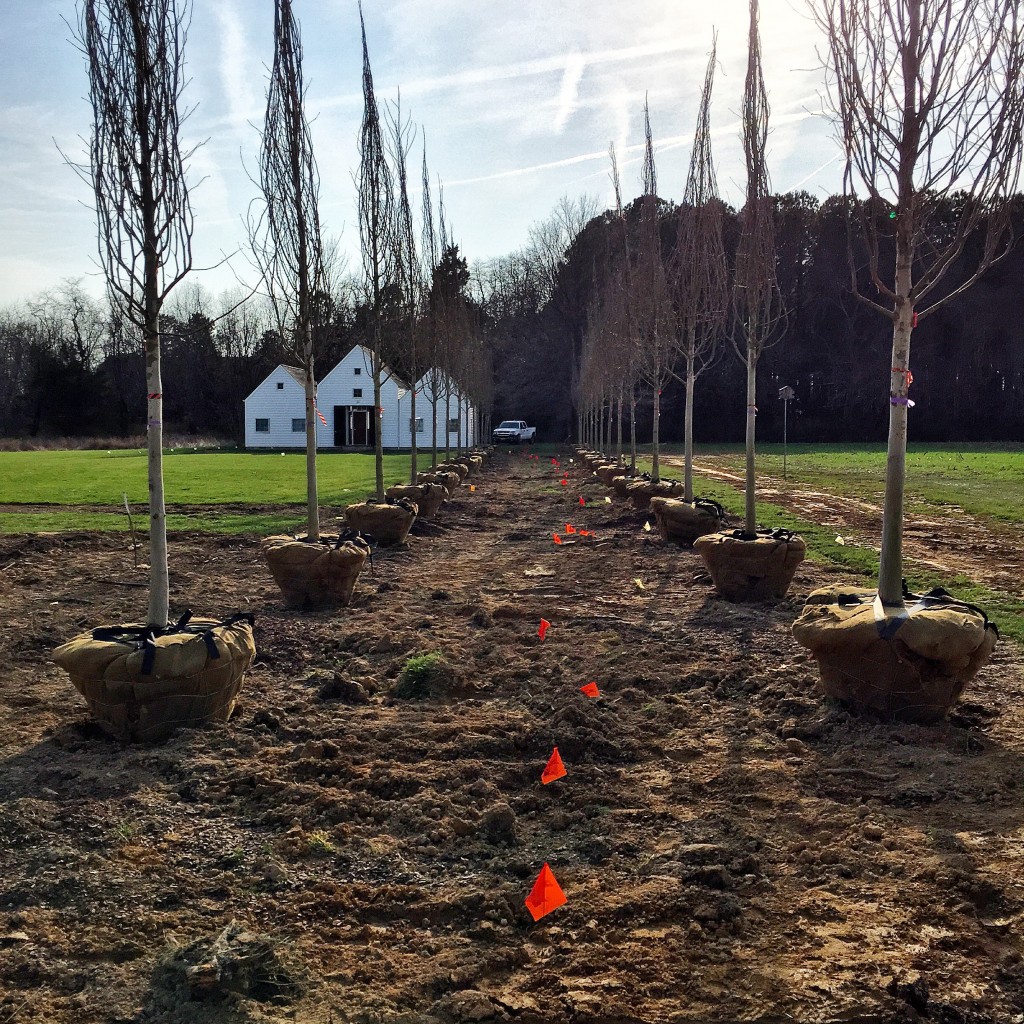
Lining it up
What advice do you have for future garden designers?
Always be working in your art. It is nearly impossible to design a garden if you aren’t working a garden of your own or one that has personal meaning.
I was fortunate to have learned refined garden techniques from master gardeners at Dumbarton Oaks, a private estate in the Georgetown neighborhood of Washington, D.C. and The Bishop’s Garden of The Washington National Cathedral. There is no substitute for learning from plants and listening to what they tell us: the exposure needed to thrive, understanding the soil, which plantings can withstand winds, sun exposure, excess shade, drought tolerance etc. If you really have a passion for gardens, if you are going to design gardens for people, and bring pleasure and peace to their environment, you have to also be working in a garden, all the time.
What do you think of the phrase “Plant food, not flowers”?
I think food is an art form of its own. That was really how I learned to love garden spaces, by my father’s vegetables, those neat tidy rows of vegetables. They are also beautiful in their own way. I understand it. I would say it’s a little bit too extreme and narrow. I would say, “Plant food and flowers.”
What do you think we need to do now with all these gardens with the drought in California?
No impervious spaces. It’s heartbreaking to watch rain water run down the streets and into the ocean. There really is no excuse for impervious walkways, driveways, terraces and drive courts, private or public. With every new construction or renovation all hardscaping should be 100 percent pervious, bringing rain water to the much needed landscape.
What is a word to describe your journey?
Discovery. Each project teaches me something new. I am continually awed by the talented tradespeople and artists I have the privilege to work with. I don’t know of another profession that brings together botanists, horticulturalists, stone masons, herbalists, architects, sculptors, gardeners, engineers, arborists and conservationists on one project.
Aris Demetrios said to me recently, “I’m 80 something years old, I’ve designed sculptures for USC and Stanford [University], and some of the best institutions around the country.” He continued, “I still feel they’re gonna come and haul me off as a fraud.” Hearing that kind of honesty from this great man was humbling, I think we all feel that way sometimes. My work requires a kind of intimacy, trust, and love for the art form of garden making and the people involved.
I remain connected to most of my gardens and their owners. My goal is to leave beauty in my wake, to leave every garden more beautiful than when I found it.
Cyrus Eaton was one of the most powerful financiers in the American Midwest. He also established the Cleveland Museum of Natural History.
Lara Morabito can be contacted at [email protected] for work in Washington, D.C., and California.



